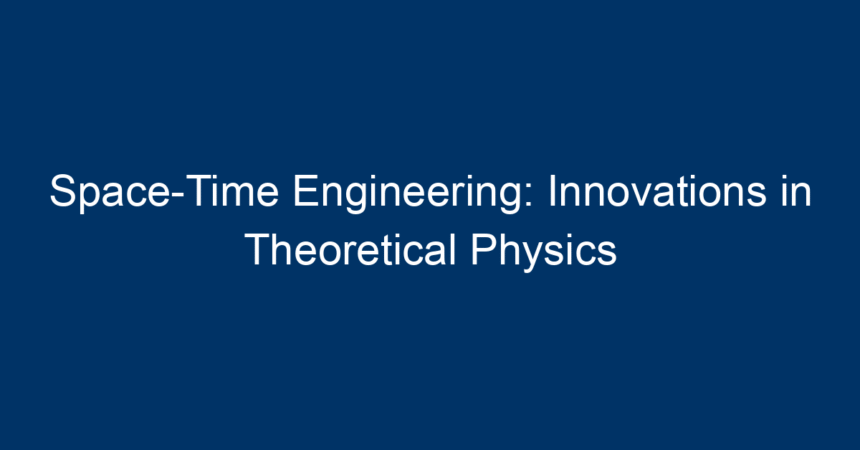Introduction
Space-time engineering is an emerging field at the intersection of physics, engineering, and theoretical concepts that challenge our understanding of the universe. With innovations that could reshape our future, this domain harnesses advanced theories from Einstein’s relativity to quantum mechanics. As humanity confronts global challenges such as climate change, energy scarcity, and technological disparities, the pursuit of understanding and manipulating space-time offers exciting possibilities. In this article, we will explore the fundamental concepts of space-time engineering, review recent advancements, and discuss practical implications.
Understanding Space-Time
What is Space-Time?
Space-time combines the three dimensions of space with the dimension of time into a single four-dimensional continuum. Proposed by Albert Einstein, it revolutionized how we perceive gravity and movement. Instead of picturing space and time as separate entities, they are interconnected within this framework. The curvature of space-time, affected by mass and energy, explains gravitational phenomena and is essential to our understanding of physics.
The Role of Einstein’s Theory of Relativity
Einstein’s theories of relativity play a crucial role in the foundation of space-time engineering. Special relativity focuses on the relationship between space and time for observers moving relative to one another, highlighting time dilation and length contraction. General relativity extends these concepts, providing insights into how massive objects influence the curvature of space-time. This understanding is pivotal for technologies like GPS, which relies on precise time measurements that account for relativistic effects.
Innovations in Space-Time Engineering
Quantum Mechanics and Space-Time Manipulation
Quantum mechanics introduces an array of possibilities for space-time engineering. The concept of entanglement, where particles become interconnected independent of distance, challenges traditional perceptions of locality in space and time. Innovations in quantum computing leverage these principles to create algorithms capable of solving complex problems quicker than conventional computers. This intersection of quantum theories and space-time could lead to breakthroughs in information processing, cryptography, and other fields.
Wormholes: Theoretical Pathways Through Space-Time
One of the more fantastical ideas in space-time engineering is the concept of wormholes—hypothetical passages through space-time that could create shortcuts between distant points in the universe. Research into traversable wormholes explores the conditions required for their existence and potential stability. While purely a concept at this stage, the mathematical formulations suggest that if they were possible, they could revolutionize travel and even communication across vast cosmic distances.
Time Travel: Bridging Theory and Practice
Time travel has long captured the public imagination, and theories around space-time engineering fuel these dreams. Based on solutions to Einstein’s equations, some hypotheses suggest methods for achieving time travel—such as using rotating black holes (Kerr black holes) or cosmic strings. While practical time travel remains in the realm of science fiction, understanding these models enhances our knowledge of physics and opens dialogues about temporal mechanics.
Real-World Applications of Space-Time Engineering
Advancements in Technology
The principles of space-time engineering find practical applications in various technologies. For instance, improvements in GPS technology depend on adjustments for time dilation effects caused by Earth’s gravity. Understanding space-time curvature also contributes to innovations in satellite technology, enhancing global communication systems and navigation.
Energy Solutions: Harnessing Space-Time Dynamics
Energy harnessing is another domain poised for transformation through space-time engineering. Researchers explore concepts like zero-point energy, derived from quantum fluctuations in empty space. Although highly theoretical, if these principles can be practically applied, they offer a nearly limitless energy source.
Space Exploration and Travel
As humanity ventures into deeper space, innovations stemming from space-time engineering are crucial. Concepts such as warp drives, proposed by physicist Miguel Alcubierre, suggest methods for faster-than-light travel. Although still speculative, such ideas fuel ongoing research and inspire future missions to distant planets and galaxies.
Challenges and Ethical Considerations
Scientific and Technical Barriers
Despite the exciting prospects, several challenges impede advancements in space-time engineering. Many concepts remain purely theoretical, requiring experimental confirmation and practical implementation. The technical complexities of manipulating space-time also pose significant hurdles, demanding breakthroughs in both theoretical physics and engineering capabilities.
Ethical Implications of Manipulating Space-Time
The ramifications of harnessing space-time raise ethical questions that society must confront as technologies evolve. Issues related to time travel, potential alternate realities, and the consequences of manipulating energy sources need careful consideration. It is essential to foster discussions among scientists, ethicists, and the public to navigate this uncharted territory responsibly.
Future Trends in Space-Time Engineering
Continued Research and Development
The future of space-time engineering relies on continuous research and collaboration across disciplines. Universities and research institutions are increasingly focusing on this field, exploring both theoretical frameworks and practical applications. Interdisciplinary approaches will be key in driving innovations, igniting curiosity, and fostering collaboration between scientists and engineers.
Public Engagement and Education
As groundbreaking discoveries unfold, engaging the public in discussions about space-time engineering becomes vital. Educational initiatives should emphasize not just the scientific principles but also the societal implications of these advancements. This dialogue will help guide responsible use, ensuring that innovations contribute positively to society.
Synergy with Other Scientific Fields
As we delve deeper into the realms of space-time, a synergistic relationship with other scientific domains becomes crucial. Areas like artificial intelligence, biotechnology, and renewable energy can significantly benefit from advances in space-time understanding. Collaborative efforts will create cross-disciplinary solutions to pressing global challenges, inspiring the next generation of innovators.
Conclusion
Space-time engineering stands at the forefront of theoretical physics, combining profound concepts with exciting innovations. As scientists and engineers uncover the mysteries of space-time, humanity stands on the brink of transforming our understanding of the universe. While challenges exist, the potential applications—from improved technologies to energy solutions—are immense. As we embrace this journey, ongoing dialogue and ethical considerations will ensure that the advancements in space-time engineering benefit all of humanity.
Actionable Insights
- Stay informed: Follow research trends in space-time engineering through scientific journals and conferences.
- Encourage interdisciplinary collaborations: Facilitate partnerships between scientists, engineers, and ethicists to drive innovative solutions.
- Advocate for public engagement: Promote educational initiatives that explore the implications of space-time engineering for future generations.
- Explore relevant career paths: For interested individuals, pursuing education in physics, engineering, or computer science can open doors to exciting fields influenced by space-time concepts.
By actively participating in the discourse surrounding space-time engineering, we can collectively shape a future where these innovations benefit society as a whole.




